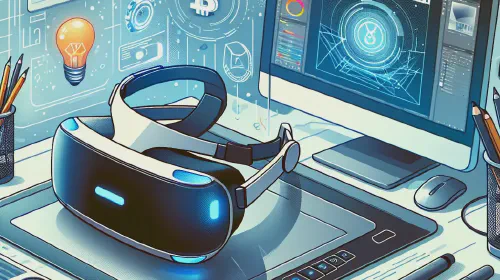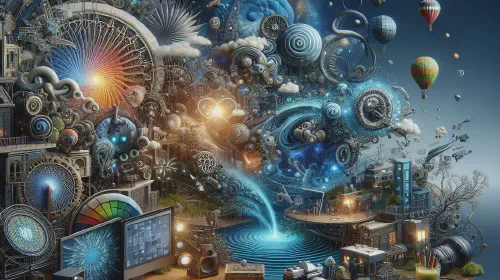Understanding Digital Art - Forms and Styles
Salomon Kisters
Dec 28, 2023This post may contain affiliate links. If you use these links to buy something we may earn a commission. Thanks!
In the ever-evolving landscape of art, the advent of digital technology has given rise to a new and exciting realm of creativity: digital art. This innovative medium transcends traditional boundaries, offering artists an unprecedented level of flexibility and expression. As we embark on this journey through the world of digital art, we will uncover the various forms that have emerged from the fusion of art and technology.
From the intricate brushstrokes of digital painting to the precision of vector graphics and the immersive experience of 3D modeling, each form offers a unique perspective and challenges the very definition of what art can be. Join us as we explore the rich tapestry of digital art, where the only limit is the artist’s imagination.
Understanding the Various Forms of Digital Art
Digital art encompasses a wide range of artistic works and practices that utilize digital technology as an essential part of the creative or presentation process. The following sections will delve into some of the most common forms of digital art, each with its unique characteristics and tools.
Digital Painting
Digital painting is an art form where traditional painting techniques such as watercolor, oils, impasto, etc., are applied using digital tools by means of a computer, a graphics tablet, and stylus, and software. Unlike other forms of digital art, particularly computer-generated art, digital painting involves the artist’s hand in creating the work, rather than relying on the computer to generate art from models or algorithms.
Artists use software like Adobe Photoshop, Corel Painter, and Krita to create their masterpieces, which can range from hyper-realistic to abstract. The flexibility of digital painting allows artists to experiment with colors, textures, and effects that might be much more challenging to achieve with traditional media.
Vector Art
Transitioning from the textured strokes of digital painting, we come to the clean lines of vector art. Vector art is created using vector graphics, which are based on mathematical formulas. These graphics are composed of points, lines, curves, and shapes that are filled with color or patterns. This form of digital art is scalable to any size without loss of quality, making it ideal for logos, illustrations, and graphic design.
Software like Adobe Illustrator, CorelDRAW, or Inkscape is often used to create vector images that maintain their crispness and detail at any scale, perfect for both print and digital media.
3D Modeling
Another dimension of digital art is 3D modeling, which involves developing a mathematical representation of any three-dimensional surface of an object via specialized software. The product is called a 3D model, and these models are used in a variety of industries including film, animation, gaming, architecture, and manufacturing. Tools like Blender, Autodesk Maya, and SketchUp are commonly used for creating 3D models.
The realism in 3D modeling can be enhanced with advanced rendering techniques that simulate lighting, shadows, and reflections, allowing artists to create detailed and lifelike models that can be viewed from any angle and animated to create dynamic scenes.
Each of these forms of digital art requires a different skill set and understanding of the tools and techniques involved. Artists may specialize in one form or combine elements from different forms to create new and innovative works of art.
Exploring Styles Within Digital Art
As we delve deeper into the digital art world, we find a variety of styles that artists have embraced, each with its own unique impact and aesthetic. Let’s explore three distinct styles: Pixel Art, Fractal Art, and Data-Moshing.
Pixel Art
Pixel Art is a form of digital art where images are created and edited at the pixel level. This style is reminiscent of the early days of computer graphics and video games. Despite its retro roots, pixel art remains popular today, embraced for its nostalgic aesthetic and the challenge of creating expressive works within its limitations. Artists working with pixel art must have a keen understanding of color theory and pixel-level editing to produce detailed and polished pieces.
Fractal Art
Moving from the pixelated images of retro games to the abstract world of mathematics, we encounter Fractal Art. This genre involves creating images using fractal generating software. Fractals are complex geometric shapes with a self-similar property, meaning they can be split into parts that are miniature copies of the whole.
Fractal art often resembles natural phenomena and requires both artistic and technical skills to manipulate mathematical formulas and parameters to generate unique patterns.
Data-Moshing
Lastly, we explore the disruptive aesthetics of Data-Moshing, a technique that manipulates the data of media files to create visual or auditory effects. This style is part of the glitch art movement, where digital or analog errors are intentionally used to create art. Data-moshing can result in abstract and sometimes unsettling imagery that challenges our expectations of digital media’s reliability.
Artists must have a deep understanding of digital file formats and video compression to alter data and create these unique effects.
Each style within digital art showcases the versatility and potential of digital media as a means of artistic expression. From the pixelated charm of retro-inspired art to the mathematical beauty of fractals and the disruptive aesthetics of data-moshing, digital art continues to push the boundaries of creativity and technology.
Conclusion: The Infinite Possibilities of Digital Art
As we conclude our exploration of digital art, it is clear that this dynamic field is more than just a new set of tools for creating art�it is a revolution in the way we conceive and interact with artistic expression. The various forms and styles we have discussed, from the meticulous craft of pixel art to the algorithmic elegance of fractal art and the experimental nature of data-moshing, represent just a glimpse of the vast potential that digital art holds.
With each technological advancement, artists are presented with new opportunities to push the boundaries of what is possible, blending creativity with innovation. Digital art is not just a testament to the ingenuity of artists; it is a reflection of our times�a digital mirror that captures the essence of a world in constant transformation.
As we move forward, one thing is certain: the realm of digital art will continue to expand, evolve, and inspire, shaping the future of artistic expression for generations to come.
Stay informed with the latest insights in Crypto, Blockchain, and Cyber-Security! Subscribe to our newsletter now to receive exclusive updates, expert analyses, and current developments directly to your inbox. Don't miss the opportunity to expand your knowledge and stay up-to-date.
Love what you're reading? Subscribe for top stories in Crypto, Blockchain, and Cyber-Security. Stay informed with exclusive updates.
Please note that the Content may have been generated with the Help of AI. The editorial content of OriginStamp AG does not constitute a recommendation for investment or purchase advice. In principle, an investment can also lead to a total loss. Therefore, please seek advice before making an investment decision.

Digital Art in the Commercial Sphere: Applications and Careers
Learn about the applications and careers in digital art within the commercial sector, focusing on branding, advertising, and user experiences. Explore the diverse opportunities in this dynamic field.

The World of Digital Art - Categories and Techniques
Discover the tools, techniques, and innovative processes behind digital painting, animation, and more, as artists push the boundaries of traditional art using digital canvases.

Protect Your Digital Payment Data: Essential Security Measures and Tips
Learn how to protect your digital payment data with essential security measures and tips. Keep your accounts safe from cyber fraud and financial loss.
Protect your documents
Your gateway to unforgeable data. Imprint the authenticity of your information with our blockchain timestamp